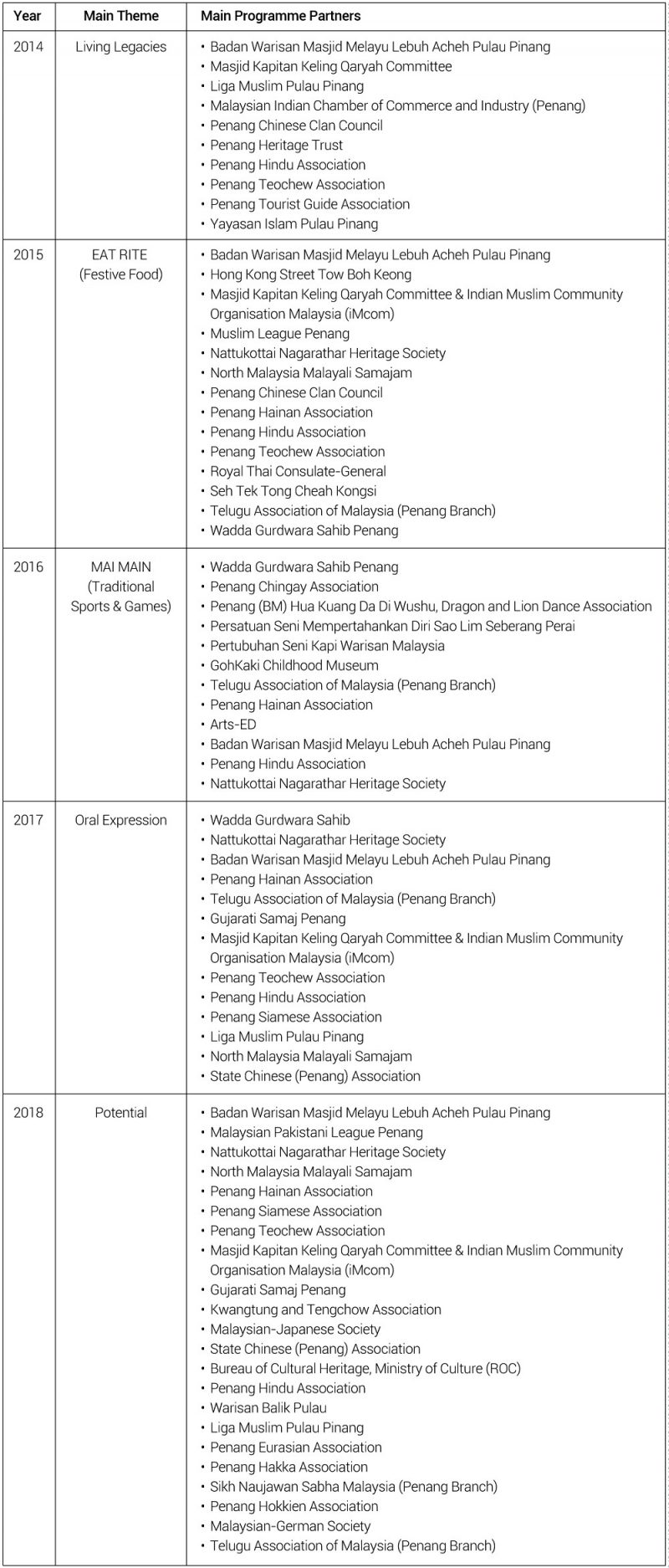Executive Summary
- A product of Penang’s heritage status, the George Town Heritage Celebrations is tasked to explore the meaning behind the city’s unique heritage as understood from the multi-layered and multiracial viewpoints of its society
- Important transitions made during the Heritage Celebrations are reflected in the governance of George Town’s heritage, including reconnecting local communities to heritage spaces, utilising streets as main event venues, and the gradual focus on experimental cultural practices
- The celebrations depict patterns of inclusivity and provide platforms to empower various communities. However, it has been considered equally important to safeguard the interests of smaller social communities outside the core circle
- Inclusivity and the widening concept of “communities” allow for cutting-edge ideas toward re-thinking the Heritage Celebrations and the current management of George Town’s intangible cultural heritage
Introduction
Cultural events are a common practice in contemporary cities as identity reflectors and for the purpose of reaping economic profits; [2] and for a city noted for its multi-cultural activities, Penang is no stranger to the trend. George Town’s inscription as a World Heritage Site in 2008 transformed Penang into an ever bigger hub for the arts, heritage and literature.
Commemorating the prestige is the annual George Town Heritage Celebrations which is tasked to explore the meaning behind George Town’s unique heritage as understood from the multi-layered and multiracial viewpoints of its society. Since the inaugural Heritage Celebrations in 2008, the value of the fete has not been gauged by the number of participants, but rather by active engagement from the local communities.
This article elaborates on several important transitions in the celebrations to shed light on the evolution of the heritage-based ideas involved.
Reconnecting local communities to heritage spaces
The Heritage Celebrations works to reconnect local communities to heritage spaces that would otherwise be publicly inaccessible on ordinary days; this is conducted through a host of cultural activities including talks, walks and performances, which create an opportunity for local visitors to relive memories of their childhood in places they used to frequent.
Active engagement with local communities is another important feature of the celebrations. The tradition stemmed from the organisers and cultural practitioners of the inaugural George Town Heritage Celebrations. In 2008, as the main organiser, the then MPPP (Penang Island Municipal Council) actively engaged NGOs such as the Penang Heritage Trust [3] and other local associations to host the three-day “George Town World Heritage Site Celebrations” event. Together with the island’s City Day Celebrations, the occasion involved associations and cultural performances within and outside George Town, as well as tours to heritage buildings and streets including the Street of Harmony – this established the precedence for future celebrations.
Several structural changes and important transitions were likewise made in 2010 to stimulate the imagination of public spaces. Firstly, the newly-formed George Town World Heritage Incorporated (GTWHI) took charge of the Heritage Celebrations and gradually positioned it as an important platform. Secondly, the perception of public space usage within the heritage site was broadened by introducing the concept of “Street Festival” whereby the streets doubled as main event venues. Under “Streets Come Alive”, various street activities were held to encourage the participation of people from different social backgrounds. The idea is not new to George Town [4], but the cross-cultural experiences in such instances remain novel.
The use of streets as venues for the Heritage Celebrations reflects the rejuvenation of public spaces for public use. On a practical level, however, it necessitates a great deal of effort to negotiate with local residences in the area since the festivities often entail a certain degree of disturbances. Nevertheless, it marks a collective action for people to rethink, re-imagine, and even be reminded of the value of balancing the interests of local residents and the public.
Focusing on experimental cultural practices
When streets are transformed into event venues, elements of intangible cultural heritage are presented and narrated as the main components – this is reflective of the shifting focus of George Town’s heritage within the heritage governance framework. While its importance has been acknowledged in the past, preservation efforts in terms of policy came much later than its tangible counterparts.
Intangible cultural heritage places emphasis on holistic views while examining heritage in relation to the surrounding environment and through the lens of culture, society and history. Unfortunately, widespread attention on the matter only gained traction when George Town started displaying signs of gentrification. To counteract the phenomenon, GTWHI, along with other stakeholders, conducted several projects to survey and record intangible cultural heritage, including oral history projects and inventories of traditional traders.
These initiatives formed the basis for the Heritage Celebrations. In 2012, with “Live Heritage” as its theme, local residents were encouraged to share their living experiences and stories with participants in the “Living Museum” programme. With “Folk Tales” as its theme in 2013, the programmes “Cherita Lebuh Chulia” and “The Splendid Trades of Yesteryear” showcased fruitful histories of the communities and their traditional trades.
The transition to more interactive activities only began in 2014 whereby heritage could be experienced and experimented with. The types of activities include crafts, festive food, games and sports, and oral expressions, rather than static cultural performances that were evident in previous years.[5] For that reason, the streets within George Town’s heritage core area were lined with pop-up vendors for participants to engage with the city’s intangible elements.
Likewise, efforts have been undertaken to encourage participation from the local communities throughout the process i.e. workshops to assist in the discovery of intangible elements within the communities’ cultures and heritages, submission of proposals for selection, and the recruiting of youth volunteers to assist visitors. These seemingly small steps are vital aspects of heritage education, resulting in the growth and maturity of communities in mobilising themselves, as well as enabling their knowledge and experiences to be maximally utilised.
Though their preservation entails difficulties, with community-based ownership as the core value, GTWHI hopes to continue safeguarding the intangible cultural heritage within the context of heritage management. This is carried out not only during festivities, but also during other activities and occasions.[6]
Integrating inclusiveness in the process
The Heritage Celebrations helps to reconnnect local communities to heritage sites. The transition of themes and platforms serves as a reminder that the festivities is not just a commemoration of the occasion, isolated from daily experiences, but rather it necessitates a deeper understanding of how George Town’s heritage is perceived. By examining certain aspects of the entire process, it is hoped that the findings will provide alternative effective means for enlivening future Heritage Celebrations, and even developing better heritage management.
While platforms have been successfully created to empower local communities, it is equally important that the interests of groups outside the core circle are safeguarded. As celebrations are among the rare existing channels for preserving intangible cultural heritage, selection and funding decisions must be afforded to the wider cultural scene, and not just limited to the Heritage Celebrations. A lack of communication between associations and communities may result in unwitting exclusion and marginalisation, hindering the affected parties from future participation, and worse still, exacerbating bad relations between the communities and the organiser.
On a basic level, there is a need for detailed elaboration in the decision-making process; this includes the selection and funding criteria of participating groups. While the Heritage Celebrations is a significant platform for protecting the city’s intangible cultural heritage, it also provides for one to reflect on the current mechanism of preservation and imagination of such cultural heritage.
Widening the different layers of “Communities”
Engaging wider “communities” in George Town during the Heritage Celebrations enhances understanding of the city’s heritage, past and present. In reality however, the UNESCO World Heritage Conventions’ operational meaning differs according to the varying social conditions.[7]
In an anthropological context, “communities” is a dynamic and social construct dependent on the natives’ points of view, and the given social conditions and moments.[8] Bearing this in mind, and instead of viewing “communities” as a given and self-evident idea, consciousness must be raised about the social and historical conditions that led to the emergence of these societies. For example, the social boundaries of George Town’s Clan Jetties are demarcated by the clans’ surnames. However, there is a tendency to recognise the Clan Jetties as a whole during religious celebrations like the Hungry Ghost festival.
In the current operation, participating communities are to a large extent composed of religious and ethnic-based associations, although some flexibility is afforded via the annual themes (Table
1). While this phenomenon rightfully reflects the long-established principle of social groups and identities formed in George Town, it is just as important to acknowledge and include smaller social groups in the formation of the city’s intangible cultural heritage. But questions arise: How can these smaller communities be incorporated into the Heritage Celebrations, and how can they dispense their valuable knowledge to the public and to provide a platform for understanding the city’s heritage?
The city’s communities and heritage form two parts of a dynamic process that has been significantly enhanced through various historicity, spaces and concepts. It is urged that the existing definitions of George Town’s social boundaries be expanded, and new policy tools implemented to meet current needs. Inclusivity and the widening concept of “communities” allow for cutting-edge ideas toward re-thinking the Heritage Celebrations and the current management of George Town’s intangible cultural heritage.
Table 1: The list of main programme community partners of the Heritage Celebrations from 2014 to 2018

[1] The author would like to thank the individuals involved in the Heritage Celebrations either as cultural practitioners or participant associations for their valuable opinions.
[2] Greg Richards and Robert Palmer, 2010, “Why Cities Need to be Eventful” Pp.1-37, Eventful Cities.
[3] Among them is Miss Ho Sheau Fung, formerly of PHT, who dedicatedly coordinated different NGOs and sectors.
[4] Various cultural festivals such as Thaipusam and Chinese New Year are typically held on the streets.
[5] Dr. Ang Ming Chee, George Town Living Heritage, 2017 Southeast Asian Collaborative Meeting on Safeguarding Intangible Cultural Heritage: Enhancing Viability in Intangible Cultural Heritage Community, 18-19 September 2017.
[6] Safeguarding Cultural Heritage: George Town Heritage Celebrations, 30th March 2017, https://jfac.jp/en/culture/features/asiahundreds020/
[7] Brumann, Christoph, 2015, Community as Myth and Reality in the UNESCO World Heritage Convention. In: Nicolas Adell, Regina F. Bendix, Chiara Bortolotto, and Markus Tauschek (eds.). Göttinger Studien zu Cultural Property. Göttingen: Universitätsverlag Göttingen, pp. 273-286.
[8] Such as Martin Mulligan, 2015, On Ambivalence and Hope in the Restless Search for Community: How to Work with the Idea of Community in the Global Age, Sociology, Vol 49, No.2, pp. 340-355.
Managing Editor: Ooi Kee Beng, Editorial Team: Regina Hoo, Nur Fitriah, Ong Wooi Leng
You might also like:
![Social Media Usage among Penangites: A Tool of Benefit or Distraction?]()
Social Media Usage among Penangites: A Tool of Benefit or Distraction?
![Trend of Investments in Batu Kawan Industrial Park]()
Trend of Investments in Batu Kawan Industrial Park
![Strengthening Malaysia’s Private Higher Education Sector through a Structural Revamp]()
Strengthening Malaysia’s Private Higher Education Sector through a Structural Revamp
![Malaysia’s Northern States: Improving Competitive Advantages and Industrial Growth]()
Malaysia’s Northern States: Improving Competitive Advantages and Industrial Growth
![Strengthening Preventive Measures against Child Sexual Abuse in Malaysia]()
Strengthening Preventive Measures against Child Sexual Abuse in Malaysia







